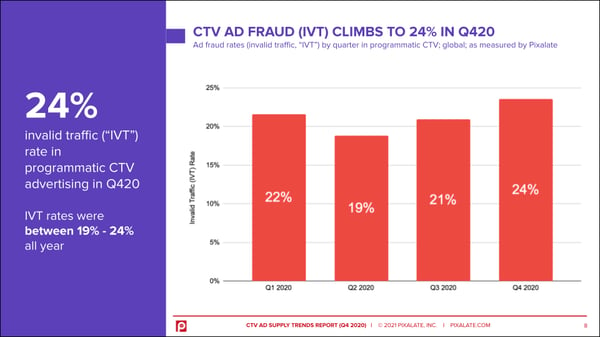
Advertising Age broke down the state of Connected TV (CTV) advertising, offering brand advertisers tips for avoiding ad fraud and “digital thievery.”
“Connected TVs are susceptible to fraud, but there also are ways for brands to protect themselves,” wrote Ad Age’s Garett Sloane. “The main way to avoid the fraud trap[s] are basic: Know your ad tech channels, know the partners that make ad inventory available in automated exchanges, and, as always, trust but verify."
The IAB Tech Lab’s VP of Programmatic Ads and Partnerships, Amit Shetty, told Ad Age that ad fraud is most problematic in open auction ecosystems. “If we really want this space to grow we will need to make sure we control that,” Shetty said, per Ad Age.
Pixalate’s 2020 CTV Ad Supply Trends Report found that programmatic CTV ad fraud rates were between 19% and 24% throughout 2020. The report is based on Pixalate’s datasets, which consist predominantly of open auction programmatic traffic sources.

The Ad Age article dives into one of the critical technical reasons CTV is susceptible to ad fraud: The widespread use of Server-Side Ad Insertion (SSAI).
SSAI is a commonly used method of programmatic ad delivery in which ad content and video content are “stitched” together to create a more seamless user experience. SSAI is typically done via proxy servers in data centers.
“When it’s working well, viewers will notice that the commercials appear almost as quickly as any other TV experience,” wrote Ad Age. “It’s particularly helpful when an app has multiple commercials in an ad break; the server can ‘stitch’ together the whole ad pod.”
However, scammers have taken advantage of the fact that a significant portion of programmatic CTV advertising runs through proxy servers.
“In an instance of [invalid] ‘server side ad insertion,’ they can just buy a whole bunch of server space and spoof a whole bunch of apps or a whole bunch of mobile phones or a whole bunch of CTV devices without actually having to buy any hardware or create any malware to infiltrate devices,” Pixalate’s Tyler Loechner said to Ad Age.
And because SSAI is so common in programmatic CTV — about 40% of programmatic CTV is transacted via SSAI, according to Pixalate’s data — it’s easier for fraudsters to blend in with the crowd.
“Always work with supply partners that select reputable ‘server side ad insertion’ vendors that support transparency standards,” such as VAST 4.x, suggested Angelos Lazaris, Chief Data Scientist at Pixalate, to Ad Age readers. Lazaris added: “Traffic sources from a supply source for a given publisher should follow an all-or-nothing approach. Either all or none of the traffic from a specific supply source and publisher combination should be ‘server side ad insertion.’”
SSAI is not the only risk factor facing CTV advertisers. As detailed in Pixalate’s CTV ad fraud scheme discoveries “DiCaprio” and “Monarch,” scammers are hitting CTV ad budgets from multiple angles.
Read the full Ad Age article for a deeper dive on other risks that CTV advertisers need to be on the lookout for — as well as more tips on how to mitigate risk best when seeking to reach CTV audiences.
Want more insight into programmatic CTV ad trends in 2020, and what it means for 2021? Join Pixalate and XUMO for a webinar on Thursday, April 8, at 1:00 pm EDT as we go in-depth on the data in Pixalate’s 2020 Connected TV (CTV) Ad Supply Trends Report. Reserve your spot today.
*By entering your email address and clicking Subscribe, you are agreeing to our Terms of Use and Privacy Policy.
These Stories on Thought Leadership
*By entering your email address and clicking Subscribe, you are agreeing to our Terms of Use and Privacy Policy.

Disclaimer: The content of this page reflects Pixalate’s opinions with respect to the factors that Pixalate believes can be useful to the digital media industry. Any proprietary data shared is grounded in Pixalate’s proprietary technology and analytics, which Pixalate is continuously evaluating and updating. Any references to outside sources should not be construed as endorsements. Pixalate’s opinions are just that - opinion, not facts or guarantees.
Per the MRC, “'Fraud' is not intended to represent fraud as defined in various laws, statutes and ordinances or as conventionally used in U.S. Court or other legal proceedings, but rather a custom definition strictly for advertising measurement purposes. Also per the MRC, “‘Invalid Traffic’ is defined generally as traffic that does not meet certain ad serving quality or completeness criteria, or otherwise does not represent legitimate ad traffic that should be included in measurement counts. Among the reasons why ad traffic may be deemed invalid is it is a result of non-human traffic (spiders, bots, etc.), or activity designed to produce fraudulent traffic.”

